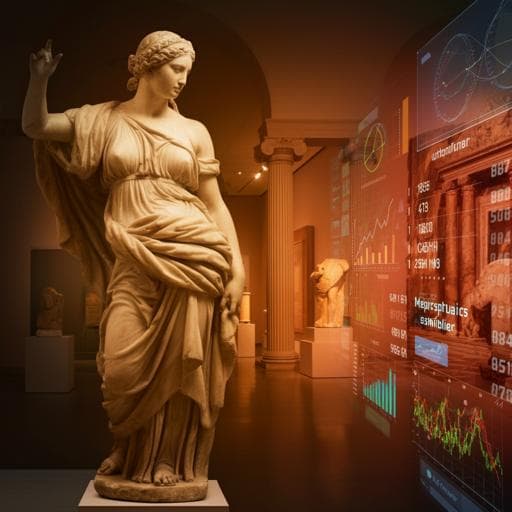
The Arts
The impact of COVID-19 on digital data practices in museums and art galleries in the UK and the US
L. Noehrer, A. Gilmore, et al.
This paper, authored by Lukas Noehrer, Abigail Gilmore, Caroline Jay, and Yo Yehudi, explores the profound changes the COVID-19 pandemic brought to museums and art galleries in the UK and US. Discover how digital engagement flourished, transforming audience dynamics and emphasizing the need for data-driven strategies.
~3 min • Beginner • English
Introduction
At the beginning of 2020 the COVID-19 pandemic forced museums worldwide to close, removing access to physical collections and precipitating a rapid pivot to digital as the primary means of engagement. This rupture prompted strategic reconsiderations about relevance, mission delivery, and the potential need to reimagine museum models in a post-pandemic context. The paper investigates how the pandemic altered digital data practices in public museums during 2020 and explores implications for future digital strategies aligned to museum missions and values. Digital data practices are defined as the ways digital data are used, perceived, and handled within and by museums and their audiences via digital technologies and computational methods. The study examines changes in access to public collections, associated challenges, and impacts on strategy, audience engagement, and business development, focusing on three museums with public collections but different governance and business models: Manchester Art Gallery (UK), The National Gallery (UK), and the Smithsonian Institution (US). It combines institutional analysis with ten in-depth interviews conducted April–October 2020, supported by a desk-based review of evidence on COVID-19’s impact on collecting institutions.
Literature Review
By April 2020, approximately 90% of museums worldwide closed due to COVID-19, creating severe strain, economic hardship, and a sharp pivot to digital (ICOM 2020a; UNESCO 2020; Finnis and Kennedy 2020). Digital responses ranged from accelerating existing strategies to struggling to keep pace, revealing sector-wide gaps in digital skills, infrastructure, and access to training and devices (Creative Industries PEC 2020; Art Fund 2020; Newman et al. 2020; Merritt 2021; Knight Foundation 2020). Institutions faced challenges in enabling staff access to data from home, providing digital access to audiences, and monetizing online assets, exacerbating inequalities and the digital divide (Holmes and Burgess 2020; Baker et al. 2020). While many projects were reduced and jobs lost or at risk (ICOM 2020a; Art Fund 2020; NEMO 2021), organizations increasingly reassessed digital’s core purpose, not as an add-on but central to delivery, with societal benefits for research, education, and wellbeing (Agostino et al. 2020; Samaroudi et al. 2020). ICOM’s follow-up survey (2020b) indicated a majority planning to increase digital offers and review strategies. Human resource issues persisted: many US museums had minimal digital staffing and few SLT members with digital expertise (Knight Foundation 2020), and organizational culture was often a barrier. Digital-only participation introduced new, diversified audiences while also amplifying inequities in access. The concept of hybrid materialities (Galani and Kidd 2020) emerged, blending digital and analogue to enable participatory remote engagement. Overall, the sector anticipated lasting changes, including strategic reviews, investment in digital skills, monetization debates, and adoption of models where physical space is no longer dominant (Art Fund 2021), positioning online audiences as key agents in digital material encounters.
Methodology
Comparative multiple-case qualitative study of three public institutions: Manchester Art Gallery (MAG, UK local authority museum within the Manchester Museum Partnership), The National Gallery (UK, DCMS-sponsored NDPB), and the Smithsonian Institution (US, multi-museum complex). Case selection was based on distinctiveness and convenience sampling as existing research partners. The study adhered to SRQR standards and received ethical approval from the University of Manchester Ethics Committee (Ref: 2020-9635-15157). Data collection comprised ten semi-structured Zoom interviews (April–October 2020) with purposively sampled professionals (directors, curators, data/digital managers, evaluation and analytics leads) with substantial experiential relevance. Participants received information sheets, gave written consent for attribution, and could withdraw within 14 days. Interviews followed an open-format guide to elicit extensive responses. Transcripts were produced and cross-checked for reliability. Data were analyzed via inductive thematic analysis in NVivo, with coding aligned to primary interview themes; intercoder agreement achieved 98.2% (n = 171) with unweighted Cohen’s Kappa κ = 0.95, indicating high agreement. Supplementary desk research analyzed each institution’s mission statements, strategic plans, policy contexts, and digital presence. Background profiles documented each museum’s history, governance, and pre-pandemic digital posture (e.g., National Gallery’s strategic objective to put digital at its heart; Smithsonian’s digital-first and open access agendas; MAG’s civic mission with limited pre-pandemic digital strategy).
Key Findings
- Digital preparedness and culture mattered: Institutions with pre-existing digital strategies and infrastructure (National Gallery, Smithsonian) transitioned more smoothly, while others (MAG) paused to reflect before building digital capacity. Organizational culture around analogue vs. digital practices influenced access and digitization priorities (e.g., reliance on analogue ledgers and dossiers impeded remote work).
- Pandemic-induced mindset shift: Widespread recognition of the value of digital data and technologies; leadership and curatorial buy-in to prioritize digital increased markedly. MAG reported ending the “analogue digital stand-off,” while the Smithsonian accelerated a pre-existing virtual strategy.
- Data-driven decision-making intensified: Leadership requested more frequent and varied metrics (e.g., reporting to trustees increased from six-weekly to weekly). Institutions leveraged dashboards, user behavior analytics, and real-time evaluation to tailor content. The Smithsonian used user input to adjust programming weekly; the National Gallery used Wi-Fi tracking and ML models to predict dwell times and visitor flows for reopening and future planning.
- Metrics challenges and skills gaps: Traditional metrics (reach, engagement, impact) proved inadequate for digital contexts, necessitating new measures and consistent definitions. There was a recognized need for data science and analytical skills to contextualize and interpret numbers for decision-making.
- Audience shifts and demand patterns: Online traffic surged; new and non-traditional audiences engaged, including first-time virtual visitors. Educational and inspiring content was most in demand, driven by homeschooling parents and teachers seeking trusted sources. The Smithsonian Learning Lab reported up to a 400% increase in traffic versus 2019, increased demand for bilingual (Spanish) and low-bandwidth/printable content, and outreach beyond devices (e.g., physical inserts at school lunch pickups and in Amazon packaging).
- Inclusion and accessibility: Digital offered opportunities to reduce threshold anxieties and engage communities (e.g., care-home residents via social media), but also highlighted the digital divide and the need for culturally sensitive, inclusive digital offerings.
- Monetization tensions and sustainability: Institutions explored charging for digital content to diversify income (notably the National Gallery), but faced tensions between revenue needs and civic missions/public funding expectations. Concerns arose about sustaining expanded digital programs alongside onsite operations post-reopening.
- Sectoral fault lines: A divide emerged between institutions with digitized, remotely accessible collections and those without; the former could continue research, documentation, and engagement during closures, while the latter were largely stalled.
- Future orientation: Participants anticipated lasting changes, with increased reliance on digital content and data to justify impact, but feared reversion to pre-pandemic norms and risk-averse cultures that could stall progress.
Discussion
Institutional strategy and digital culture significantly influenced pandemic responsiveness and ongoing transformation. The cases corroborate wider sector evidence: hybrid materialities and data-informed online engagement created new opportunities for participation and strategic learning, while persistent gaps in metrics, skills, and organizational culture constrained progress. Prepared institutions leveraged infrastructure to innovate (e.g., real-time user analytics, predictive modeling for visitor management), potentially broadening access and addressing aspects of social inequality. However, the adequacy of measures for digital reach, engagement, and impact remains unresolved, underscoring the need for research-backed frameworks and investment in analytical capacity. Organizational culture emerged as a critical determinant of success, often more so than finances alone, highlighting the importance of leadership commitment to embed digital across operations and to sustain blended onsite–online models. Comparative analysis shows that despite shared civic missions, differences in governance, policy environments, and pre-pandemic digital investments shaped trajectories, with MAG using the pause for reflection and learning and the Smithsonian and National Gallery scaling digital programs and data practices. Overall, digital strategies are becoming central to mission delivery, conservation, research, and audience development, necessitating long-term investment and cultural change.
Conclusion
COVID-19 catalyzed a structural shift in museums’ digital data practices, with effects extending beyond temporary closures. Institutions demonstrated resilience by adapting strategies and operations to a digital-centric paradigm. The study’s in-depth analysis of three public institutions in the UK and US, supported by sector literature, indicates that strategic foresight, organizational culture, and investment in digital capacities and skills are pivotal to future sustainability and public value delivery. The sector is likely to continue integrating data-informed digital engagement alongside onsite experiences, addressing inclusion, accessibility, and new audience behaviors. Future work should develop robust, standardized metrics for digital performance, evaluate monetization models consistent with civic missions, and explore blended operational models. Continued investment in digitization, interoperable metadata, data science capability, and leadership-driven cultural change will be crucial for museums to survive and thrive post-pandemic.
Limitations
The case studies focus on three relatively well-funded public institutions in the UK and US, which may limit generalizability to smaller or less resourced museums and to other national contexts. Data are drawn from ten interviews during April–October 2020 and desk research within the early pandemic phase; findings reflect that timeframe and may not capture longer-term evolutions. Access to primary datasets is restricted; data are available from the corresponding author on reasonable request. The study highlights but does not resolve sector-wide issues around standardized digital metrics and impact measurement.
Related Publications
Explore these studies to deepen your understanding of the subject.







